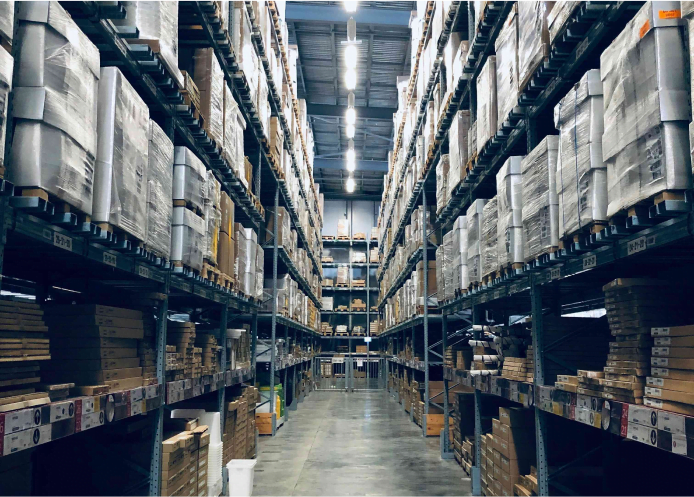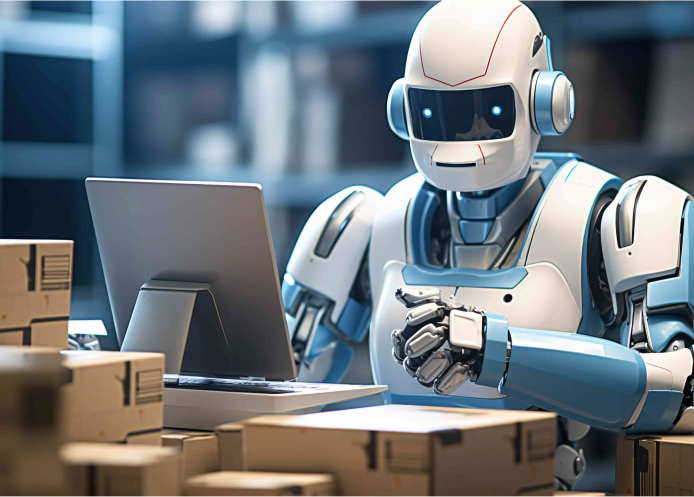Welcome to a buzzing new edition where we unveil how generative AI in eCommerce is pivotal in transforming shopping experiences. Imagine walking into a digital store where the product descriptions know exactly what you’re looking for or chatting with a bot that’s ready to assist at any moment. This isn’t a scene from a sci-fi movie—it’s the reality today for major retailers like Amazon and Target.
The AI Influence on Major Retailers
In this edition, we dive into the corridors of major eCommerce platforms to explore how AI-driven tools are not just augmenting but fundamentally altering the operational dynamics. From AI-scripted product descriptions that remarkably resonate with your preferences, to smart chatbots easing store staff workloads, the retail environment is undergoing a significant transformation, making shopping more intuitive and user-friendly than ever before.
Sustainability Steps Forward
We also spotlight a major sustainability push with Amazon’s transition from plastic air pillows to eco-friendlier packaging options. Though it might seem like a minor adjustment, this initiative is poised to have a monumental impact on delivery practices, underlining a brewing revolution in how eCommerce giants are thinking about environmental responsibility.
Deep Dive into Labor and Technology
Further in, we tackle Amazon’s recent challenges around labor law violations, highlighting the hefty fines and growing unionization movements that could redefine worker rights in eCommerce. Meanwhile, as technology continues to evolve, we’ll also examine the latest advancements in payment technologies and AI-enhanced shopping tools that are making the retail space smarter and more personalized.
Whether you’re an eCommerce marketer, a store owner or just an enthusiast following the latest in eCommerce evolution, join us as we dissect these emerging trends and technologies that are defining the future of retail.
Generative AI in eCommerce: Transforming Shopping Experiences
Welcome to a new era in eCommerce, where generative AI is no longer just a futuristic concept but a dynamic reality actively transforming shopping experiences. Giants like Amazon and Target are at the forefront of this revolution, utilizing artificial intelligence to enhance efficiency, personalization, and customer engagement in remarkable ways.

Amazon’s Leap into AI-Driven Commerce
Imagine a digital marketplace where every product description is engineered to be compelling. That’s the reality at Amazon, where over 200,000 sellers leverage generative AI tools to craft descriptions that don’t just describe products, but actively sell them. This massive adoption highlights a significant trust in AI capabilities, showcasing the technology’s ability to generate not only accurate and detailed content but also descriptions that capture the nuances of persuasive writing tailored to consumer preferences.
These tools go beyond basic text generation; they offer a strategic advantage by creating personalized shopping experiences. Just as a skilled salesperson would, AI analyzes browsing and purchase history to tailor product descriptions that resonate on a personal level, encouraging that all-important click on the ‘add to cart’ button.</ session trends>
Target’s Innovative AI Chatbot for Enhancing In-store Efficiency
Switching our focus to physical retail, Target is pioneering the use of generative AI on the shop floor. The introduction of an AI chatbot, as reported by Retail Dive, is enhancing the way store employees interact with both products and customers. This AI tool supports staff by providing instant access to critical information like stock levels and product placements, which significantly smoothens the customer service process. Instead of scrambling for information, employees can deliver quick and accurate responses, making shopping seamless and enjoyable for customers and less stressful for the staff.
The chatbot is not just a repository of information but a proactive assistant that helps in managing store dynamics. This includes handling customer queries efficiently, thereby fostering a more engaging and personalized shopping experience. Such technological integration suggests a strategic shift towards more responsive and adaptive customer service, utilizing AI not just for operational efficiency but as a cornerstone for customer interaction.
The Broader Impact of AI on Buyer-Seller Dynamics
The widespread integration of AI in eCommerce doesn’t just change how transactions are made; it also reshapes the foundational dynamics of shopping. AI’s role in facilitating a more personalized, efficient, and engaging shopping experience speaks to a larger trend of digital transformation in retail. It’s interesting to ponder how these AI tools, once perceived as impersonal and mechanical, are now pivotal in enhancing human interactions in commerce settings, making them richer and more responsive.
As we continue to navigate this evolving landscape, the intriguing aspect is how these tools adapt and learn from user interactions, potentially offering even more personalized and nuanced shopping experiences over time. It’s an exciting time in retail and eCommerce, with generative AI leading the charge in bridging the gap between digital convenience and personalized shopping.
In conclusion, as we look forward to our next shopping experience, whether online or in-store, it’s clear that generative AI is set to play a crucial role. Embrace the change, and you might find that AI can offer an unexpectedly warm welcome, transforming not just how we shop but also how we interact with the very fabric of retail.
Amazon Leads the Charge in Ecommerce’s Sustainable Revolution
Welcome to the forefront of a crucial shift in ecommerce practices—a movement towards sustainability that is not just commendable but essential for our planet’s future. As we delve into the eCommerce landscape, one player, in particular, is setting an unprecedented standard: Amazon. Known for their colossal package distribution, which includes shipping about 2.5 billion packages yearly in the U.S. alone, they’ve recently made headlines with a groundbreaking announcement. In a significant eco-friendly pivot, Amazon has decided to eliminate plastic air pillows from their packaging, opting instead for alternatives like recyclable Kraft paper.

The Environmental Cost of Convenience
Imagine millions of parcels crisscrossing the globe, each safeguarded with lightweight, yet environmentally detrimental plastic air pillows. While these fillers have been the norm due to their protective qualities, their inability to decompose or be readily recycled contributes massively to the mounting crisis of plastic waste. With this decisive move away from such materials, Amazon is not just adhering to regulatory pressures or sustainable trends; they are reshaping consumer expectations and industry standards.
Consumer Consciousness Driving Change
In today’s market, the environmental consciousness of consumers is palpable. People are increasingly making purchasing decisions based on the sustainability of products and the corporate responsibility of companies. By integrating more sustainable practices, Amazon is not only nurturing a positive brand image but also aligning itself with the eco-friendly demands of its customer base. Their strategy signifies a deeper understanding that modern consumers regard environmental impact as a crucial factor in their buying behavior, compelling other companies to take notice and follow suit.
The Ripple Effect in the Ecommerce Ecosystem
Amazon’s initiative is likely to create a ripple effect, inspiring other companies, small and large, to reevaluate and possibly revamp their packaging solutions. This industry-wide shift could enhance sustainable practices across the entire supply chain, from manufacturers to retailers. By setting such a high benchmark, Amazon is not only advocating for environmental sustainability but also propelling the ecommerce sector towards more responsible operations.
As ecommerce continues to expand, integrating sustainability into business operations goes from being an optional strategy to a mandatory approach for future-proofing business models. Amazon’s move might just be the catalyst needed for widespread adoption of sustainable practices that balance ecological health with commercial success.
Conclusion: A Call for Collective Action
Each time you make an online purchase, consider the environmental impact of your choice. The journey of a single package, though seemingly trivial, cumulatively contributes to significant ecological footprints. Through conscious choices and support for brands that prioritize sustainability, even the smallest acts can propel large-scale environmental change. With Amazon leading by example, the ecommerce domain stands on the brink of a major transformation. It’s an exciting time to watch, engage, and support this green evolution in ecommerce, propelling us towards a more sustainable, responsible future.
The Rising Storm: Amazon’s Labor Law Violations and Unionization
As we delve into the intricacies of generative AI in eCommerce, it’s impossible to ignore the human backdrop against which these technologies are deployed. Today, we’re discussing an issue that presents a significant challenge in the eCommerce sector, especially highlighted by recent events at Amazon. This isn’t just about algorithms and data; it’s about the people who make these digital platforms function day in and day out.

Amazon’s Staggering $5.9 Million Fine
Amazon, a company that’s become synonymous with online shopping, has recently been under the spotlight, not for its vast product range or innovative technology, but for a more contentious reason. The eCommerce giant has been fined a hefty $5.9 million for over 59,000 violations of California labor laws. This staggering number of violations highlights a serious disregard for the labor standards that are put in place to protect workers. What does it take for such a prolific company to accumulate this many infractions? This points to systemic issues in how worker rights and well-being are managed and safeguarded.
The Impact of Labor Laws on Workplace Fairness
Labor laws are designed as a safeguard for fairness in the workplace, covering essential aspects such as breaks, overtime pay, and safe working conditions. When a company infringes upon these laws, it doesn’t only harm the employees but also affects broader societal constructs like economic stability and family well-being. The ramifications of Amazon’s violations send a clear message about the need for stringent enforcement of labor laws to protect employees and maintain social equity.
A Bold Move Towards Unionization
In response to ongoing labor issues, there’s been a significant development within Amazon’s workforce. The Amazon Labor Union, in a powerful statement of collective resolve, has voted to join forces with the Teamsters. This unionization move is not just a critical step for Amazon’s employee network but is also indicative of a larger trend across eCommerce platforms. The involvement of the Teamsters, a union known for its strong negotiations, might usher in a new era of labor relations in the digital commerce space.
Why This Matters to Us All
This unfolding scenario at Amazon isn’t just an isolated corporate saga; it’s symptomatic of the eCommerce industry at large. Each order we place online indirectly ties us to the conditions and rights of the workers in warehouses and distribution centers. Understanding the challenges employees face in eCommerce giants like Amazon helps us, as consumers, become more empathetic and informed about the broader implications of our online shopping habits.
Furthermore, by scrutinizing how companies treat their workforce, we gain insight into the future landscape of work in an increasingly digital world. It’s essential to consider not only our immediate benefits as consumers but also the long-term societal impacts of our consumption patterns.
Conclusion: Looking Beyond the Horizon
As we continue to track these developments, let’s recognize the deeper story—a narrative about human dignity, rights, and the evolving dynamics of labor in the digital age. The story of Amazon’s labor challenges and unionization efforts serves as a crucial lesson for other eCommerce entities and for us as stakeholders in this digital ecosystem. It’s a call to action for all involved to prioritize humane and fair labor practices in the fast-evolving digital world.
Stay tuned as we explore further the intersection of technology, commerce, and labor, and remember, each choice and click can contribute to shaping a fairer work environment for everyone.
Revolutionizing eCommerce: Embracing Generative AI and Shoppable Content
As the digital marketplace evolves, generative AI in eCommerce is reshaping how merchants interact with and serve their customers. One of the most transformative aspects has been in payment processing. Traditionally dominated by credit cards and PayPal, the landscape is swiftly shifting towards more innovative solutions like Apple Pay, Google Wallet, and cryptocurrencies such as Bitcoin. These emerging payment technologies offer not only newer ways to transact but also redefine user experience by providing faster, more secure, and seamless payment options. Merchants Weigh In on Payment Processing provides a comprehensive look at these changes and their implications for businesses and consumers alike.

Enhancing Customer Trust with Advanced Payment Solutions
Consider a young entrepreneur in the custom skateboard business. By leveraging the latest in payment technology, they not only streamline the purchasing process but significantly elevate customer trust and satisfaction. It’s not just about keeping pace with technological advancements; it’s about strategically integrating tools that enhance the buying experience, setting their business apart from those sticking to outdated methods.
Shoppable Content: The New Frontier in Omni-Channel Commerce
An even more groundbreaking trend is the rise of shoppable content, which integrates pure eCommerce opportunities right into the media consumers enjoy every day. Imagine the advantage of watching a video tutorial on the latest skateboard tricks and being able to click directly on the video to purchase the showcased skateboard or gear. This concept, detailed in Shoppable content – the new omnichannel commerce frontier, not only makes the shopping experience more engaging but also seamless. From Instagram influencers to cooking shows on YouTube, every piece of content can potentially lead to a direct sale, blurring the lines between entertainment, engagement, and shopping.
Staying Agile in a Rapidly Evolving Marketplace
With these new technologies, the necessity for businesses to remain adaptable has never been more critical. The ability to experiment with new payment models and integrative content strategies is key to staying relevant and meeting customers right where they are. What this means for entrepreneurs and eCommerce managers is a continuous commitment to understanding and implementing generative AI and other emerging technologies within their eCommerce platforms.
The expanding eCommerce landscape offers vast opportunities facilitated by technology integration, affecting everything from marketing strategies to daily consumer interactions. Embracing these changes isn’t just beneficial; it’s essential for staying ahead in the dynamic world of eCommerce. Keep exploring, keep innovating and remember that in this digital age, being afraid to click the ‘buy’ button might just mean missing out on the next big opportunity.
Revolutionizing Retail: How Walmart and Best Buy Are Pioneering with Technology
The realm of retail is witnessing a technological transformation that could redefine consumer experiences. Giants in the industry like Walmart and Best Buy are not just adapting to technological trends—they are setting the pace. In this analysis, we explore how these companies leverage cutting-edge technologies to enhance customer satisfaction and streamline operations, pointing towards a future where generative AI in eCommerce plays a pivotal role.

Innovative Crop Monitoring at Walmart
Firstly, let’s delve into Walmart’s groundbreaking initiative. Imagine choosing an apple and knowing its complete backstory—from the seed to the store. This futuristic concept is becoming a reality with Walmart’s new crop monitoring technology. By providing detailed insights about produce freshness and origin, Walmart not only facilitates more informed buying choices but also promotes sustainability. This technology tracks each product from inception, through growth stages, right up to delivery, ensuring optimal freshness and nutritional value. By enhancing efficiency in farming and reducing waste, Walmart is making strides toward a more sustainable and informed shopping experience. You can read more about their efforts on this front in Grocery Dive’s coverage.
Best Buy and Microsoft’s AI-Driven PCs
Shifting focus to Best Buy, their collaboration with Microsoft has introduced an exceptional range of AI-enhanced PCs. This exclusive partnership aims to redefine the traditional computer buying and using experience. Targeting everyone from students to professionals, these PCs are not just machines but intelligent assistants designed to adapt to and anticipate the user’s needs. Be it enhancing productivity or gaming experiences, these AI-driven devices promise a personalized and intuitive interaction. This innovative step is a clear indicator of how retail leaders like Best Buy are harnessing the power of generative AI in eCommerce to offer more tailored services and products. Details of this partnership are thoroughly explained in Chain Store Age.
The Bigger Picture in Retail Technology Adoption
Both Walmart and Best Buy’s initiatives illustrate a larger trend in the retail sector’s interaction with advanced technologies. This isn’t just about employing new tools; it’s about creating a more personalized, efficient, and sustainable consumer experience. The proactive approach of these retail magnates in embedding advanced technologies into their operations signifies a shift in how shopping is perceived and executed. It heralds a future where technology isn’t just an add-on but a fundamental aspect of the retail landscape.
In conclusion, the adoption of technologies such as AI by retail giants like Walmart and Best Buy is a testament to the sector’s robust dynamic nature. These innovations are not merely responses to evolving market demands but are steps towards shaping the future of retail. As these technologies continue to mature, the potential for their influence in personalizing and enhancing the consumer journey is immense. It’s indeed a thrilling time to witness and adapt to these changes, promising a markedly different and exciting future for retail.
Stay tuned as we continue to explore more about these fascinating developments and their implications for the ever-evolving world of eCommerce.
Innovating into the Future: Your Role in Shaping eCommerce
As we conclude another week of groundbreaking developments in eCommerce, it’s clear that the terrain is rapidly evolving. The integration of generative AI platforms is not just a trend—it’s the future. But what does this mean for you, the savvy eCommerce professional?
Companies like Amazon and Target are already rewriting the rules of customer engagement and product marketing using AI technologies. This is not just about personalization; it’s about creating entire ecosystems where consumer needs are anticipated and met with previously unimaginable efficiency. The shift towards eco-friendliness in packaging reflects a broader consumer expectation: responsibility doesn’t oppose profitability.

Engage, Question, and Innovate
Now, let’s turn the spotlight onto you. How can you leverage these shifts in your own strategy? Are there opportunities within your business to integrate AI more deeply to enhance the customer experience? Perhaps, it’s time to rethink how environmental policies are not just good ethics, but also great business tactics.
What’s Your Next Move?
- How will the rise of generative AI alter your approach to eCommerce management?
- In what ways can you make your packaging more sustainable to mirror industry leaders like Amazon?
- With the ongoing labor revolutions, how will your brand support fair labor practices while maintaining efficiency?
The world of eCommerce is adapting, and there is infinite potential for those ready to innovate. We invite you to leave your thoughts in the comments below or on our social media platforms. How are you planning to incorporate these developments into your strategies?
Stay Ahead with Blikket.co
Remember, the journey does not end here. Continue to explore, question, and challenge the status quo. Visit Blikket.co for more insights, trends, and updates. Together, let’s shape the future of eCommerce.
Thank you for following our coverage on The Checkout Point. Join us next week for more insights and never hesitate to reach out with your observations and questions. Until then, innovate boldly and see you on the digital frontier!










